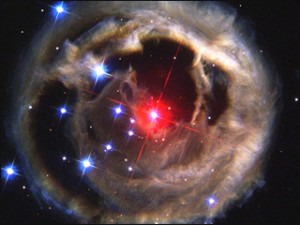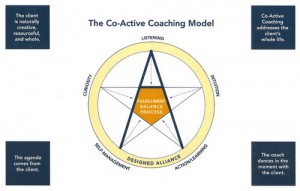The Co-Active Coaching Model
The Co-Active approach comes from “Co-Active Coaching – New skills for coaching people toward success”, by Laura Whitworth, Karen & Henry Kimsey-House and Phillip Sandahl, and offers a different approach to the “GROW” model we know and love…!
(A) The 4 cornerstones
These four cornerstones form the foundation of co-active coaching:
The Client is Naturally Creative, Resourceful and Whole
the approach to coaching practice comes from the belief that clients have the answers or they can find the answers if they are asked the right questions. From the co-active coach’s point of view nothing is wrong or broken and there is no need to “fix” the client. the Coach is simply discovering, uncovering or polishing the individual that people already are.
The Agenda Comes from the Client
This means that the coach / client relationship is focused on getting the results that the client wants, not what the coach or anyone else thinks is best for the client. It is the coach’s task to ensure that the clients are always steering towards fulfillment and balance, and are able to engage in the process of their lives.
The Coach Dances in the Moment
Quite often when Coaches start working with one issue or inquiry, they will find that there is something else underneath or behind it that will pop up. Dancing in the moment means that they will deal with or just be with whatever comes up in each moment and know that what ever arises and wherever individuals are in this moment is the perfect place for them right now. Everything that is happening is an opportunity for learning and movement.
Co-Active Coaching Addresses the Client’s Whole Life
Because we are human being and not programmes set to perform a specific function and no other, we often cannot separate or compartmentalize the different aspects of our lives into neat little boxes. Everything is connected in some way and so co-active coaching relationships must be able to work with aspects of every area of a person’s life: work, home, family, relationship, money, and intimacy and so on.
(B) Designed Alliance (encircling the principles and contexts)
The Designed Alliance is the container that the coach and client create together, in which the coaching takes place. Each alliance will be unique to the coach and client and it has the ability to shift and change with the needs of the coaching relationship and the specific client. The designing of the alliance usually takes place during the “Discovery Session”, where the client and coach talk openly about how they will work together and what agreements must be in place in order for this relationship to be as effective as possible in meeting the client’s needs.
 (C) 5 Contexts: the “points” of the star
(C) 5 Contexts: the “points” of the star
In the Co-active coaching model, focused in on the client and their fulfillment, balance and process, are the five contexts of Co-Active Coaching: listening, curiosity, intuition, self management and forward the action / deepen the learning. Together within the parameters of the Designed Alliance, these contexts will help to create the ground in which the coaching unfolds.
Listening
It seems rather obvious that a coach would have to listen to the client, however there are many ways to listen to someone and on several different levels. Sometimes listening to what people are avoiding saying or to what they are saying with their tone, body language or other non verbal communications, is every bit as important as what they do say. Have a look at the blog on listening skills and models
Curiosity
One of the coach’s primary jobs is to be curious and ask provocative, open ended and inviting questions that will invite the client to look in a direction or another, but with no preconceived conclusion. These are not leading questions, and the coach is not attached to the answer they receive. If it is not a fruitful or relevant place to look, the client will know and say so, or the coach will see that it was a dead end and ask a different question.
Exploring together from the context of curiosity allows for non threatening exploration from a playful and innocent state, full of wonder and lacking in judgment. Curious questions like, “I wonder what you want?” “I wonder what your life would be like if you could design it anyway you like.” “I wonder what is holding you back” can be fun and exciting or even powerful and surprising to ponder.
Intuition
Our intuition or sixth sense, tells us things about our environment that the senses of sight, sound, smell, taste and touch cannot tell us if we develop, strengthen and learn to listen to it. Quite often we can get a “gut reaction” and not listen to it because we do not trust our intuition or instincts. In Co-active coaching people are taught that it is not so much about “being right” with their intuition, but the key is to have their senses sensitively tuned in to pick up signals, and then to speak directly from that place of intuition and then dance in the moment with what ever shows up.
Self Management
In order for the coach to hold the client’s agenda in the forefront, he or she must be able to effectively manage “their own stuff” in lots of different ways. This can range from keeping an open mind when presented with something that the coach has strong personal feelings about, to not rushing in to “give the answer” or rescue a client when they seem “stuck”, and also keeping in mind that your answer as the coach may not be the right answer at all for the client.
We all have our own experiences, opinions and approaches to doing things but it is important for the coach to remember that the client has or can find his or her own answer and that the coach’s job is to simply find the questions that reveal it.
Forward the Action / Deepen the Learning
One of the things that sets a coaching relationship apart from other similar ones is the focus on the client’s action. Clients come to coaching with a desire to move forward in their lives which is why “forwarding the action” is a core quality. Over time the client can see the progress of these actions but in the process of doing there is often also a lot of learning that takes place. Learning comes in many forms, from what they learn about themselves and their desires, to what they learn through their actions and even what they learn by not taking action. This is why the co-active model pairs “deepening the learning” with “forwarding the action”.
(D) Principles (centre of the star)
Fulfillment
Each person’s concept of what is fulfilling is unique and intensely personal. Fulfillment does not have to be a long term goal or an elusive dream of the future. It is available to each of us today, in each moment, by living in harmony with what we most value now. Achieving goals can be very satisfying indeed, but most clients find that living a life on purpose, on the path toward the goal is fulfilling as well.
Balance
Because life is always in motion, balance is a dynamic concept. We are always moving toward balance or away from it. It is never static, or a destination to be reached once and for all. When coaches approach a coaching session from the principle of “balance”, they determine what perspective the client is holding about the issue in question, and then brainstorm together and explore other possible perspectives to give them access to a variety of choices. The power of conscious choice gives individuals far greater control over their life and from there the individual (with the coach’s help at times) has the ability to create a plan of action, commit to that plan and move forward with greater confidence and certainty.
Process
We are always in the process of our lives. Sometimes it looks elegant, graceful and flowing and sometimes it is stuck in the mud. Sometimes it is beautiful and joyful and other times it is painful and really hard to bear. Where ever we are in process is where we are – whether we like it there or not. It sometimes “just is what it is”. Skipping through the process quickly or avoiding feeling your feelings will sometimes delay the process. The old saying: “That which we resist, persists” comes to mind. The coach’s function at times will be to just be with the client where they are, and help the client to go through the process so that they can get to the other side.


